RETRACTED: The Influence of Intelligent Visual Sensing Technology on Online English Teaching in Wireless Network Environment
Abstract
The study is aimed at improving the quality of online English teaching and enhancing students’ English learning ability and effect. First, the current situation of online English teaching is analyzed. Second, the image recognition algorithm in artificial intelligence (AI) visual sensing technology is used to process the image, and the effects of illumination and image acquisition angle are analyzed. Finally, AI image recognition technology is applied to online English teaching, and its impact on online English teaching is analyzed. The results show that AI visual sensing technology can accurately recognize students’ facial information. Therefore, it can confirm the identity of students, help to count the number of students in online English teaching, and improve students’ autonomous learning ability. In addition, it can also record students’ facial information in real time and analyze students’ emotional changes in the learning process to adjust the teaching process and improve the teaching quality in an all-round way. The results provide technical support for improving online English teaching and contribute to English teaching reform.
1. Introduction
English teaching is a subject that needs the comprehensive development of listening, speaking, reading, and writing, so English teaching needs to be conducted comprehensively [1]. As a popular teaching method at present, online English teaching is an English learning method for students to learn online through wireless network technology. This learning method mainly depends on students’ awareness and ability of autonomous learning. Although online English teaching is not perfect, many studies have provided technical support and teaching direction for it.
Guan pointed out that the theory of second language acquisition has entered the era of network exploration with the rapid development of science and technology and the universal application of the Internet [2]. Kong pointed out that the Internet has become an important component of college students’ school life due to the rapid progress of the Internet in China. Almost all students can use the Internet to complete film viewing and learning. The construction of the English online course is of great significance to college English course teaching, which can effectively cultivate and enhance students’ interest in learning English and then improve the classroom teaching efficiency [3]. Zhang pointed out that the integration of information technology and English curriculum has deepened the application of artificial intelligence (AI) in the teaching field, created a new opportunity for the optimization of the English teaching process, and opened up a new space for the construction of intelligent and personalized English teaching environment [4]. Cunningham pointed out that traditional middle school English teaching methods have been widely criticized for a long time due to various problems and deficiencies. The new English curriculum standard issued by the Ministry of Education also puts forward new requirements for middle school English teaching reform. However, crises often mean a turnaround. With the advancement of the integration of information technology and the English curriculum, the application of AI in the teaching field also brings new opportunities for the optimization of the middle school English teaching process and provides a new platform for the creation of an intelligent and personalized English teaching environment [5]. Huang et al. pointed out that image recognition is a technology that computers process, analyze, and understand images to identify targets and objects of different modes. It realizes the transformation from image information to text information, which is a quite crucial step in the development of modern computer technology. The recognition process includes image preprocessing, image segmentation, feature extraction, and judgment matching, so that the computer can read the image content like a person, including video content recognition, optical character recognition (OCR), and other subdivided fields. It has multiple applications in the fields of automatic image classification and sorting, image optimization, character recognition, face recognition, and video surveillance and security [6].
To sum up, AI provides strong technical support for online English teaching with the development of wireless network technology. First, online English teaching is deeply understood. On this basis, the image recognition algorithm in AI visual sensing technology is analyzed and improved and then used for the identification and determination of students and teachers in online learning. Finally, the emotions of students and teachers are analyzed to provide students’ learning dynamics in online English teaching. This thesis will provide technical support for the improvement of the effect of online English teaching and contribute to the improvement of the quality of students’ online English learning.
2. English Online Education and AI Visual Sensing Technology
2.1. English Online Teaching and AI Visual Sensing Technology Theory
Since the reform and opening up, English teaching has been regarded as a compulsory subject of basic education throughout the whole educational approach. The education and teaching mode of the English curriculum is gradually improved with the continuous promotion and strengthening of the education department, and the teaching scale and teaching level are also continuously improved [7]. Continuous exploration shows that English teaching needs to be carried out comprehensively from the aspects of words, listening, and speaking. The way of education should include not only the classroom teaching in the school but also students’ autonomous learning, because the improvement of vocabulary, listening, and oral English requires a lot of practice [8]. Thereby, the research on the optimization of English online teaching is a hot issue in English teaching reform, which is directly related to the success of education reform [9].
With the advancement of teaching reform, the traditional classroom teaching model can no longer meet the requirements of the long-term development of English teaching [10]. The rapid progress of wireless network technology greatly assists the transformation of the English teaching model. The intelligent teaching mode comes into being through the development of the computer. This mode is divided into three stages, namely behaviorism computer-aided language teaching, interactive computer-aided language teaching, and integrated computer-aided language teaching [11]. Figure 1 shows the transformation of education mode under wireless network technology.
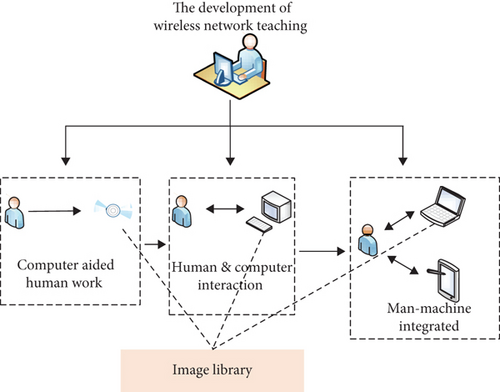
Figure 1 reveals that the alternating extension of the three education stages reflects the gradual improvement of online English teaching. AI begins to become the main way of English teaching with the emergence of the integrated computer-aided language teaching stage. It realizes the highly anthropomorphic technology of machine thinking, which comprehensively improves students’ English learning and application ability mainly by strengthening students’ discovery, expression, and development ability [12].
The development of wireless network technology has led to the emergence of multiple fields. Wireless network technology covers a wide range, including not only global voice and data networks that allow users to establish long-distance wireless connections but also infrared technology and radio frequency technology optimized for short-distance wireless connections [13]. Devices commonly used in wireless networks include portable computers, desktop computers, handheld computers, personal digital assistants (PDAs), and mobile phones. Wireless technology is used for multiple practical purposes, among which AI is a more advanced technology born under wireless network technology [14].
With the emergence of AI, English teaching can not only realize the management automation in the online classroom but also realize the teaching personalization and environment virtualization of online autonomous learning. In online classroom teaching, teachers can analyze students’ characteristics through the image recognition technology in AI’s visual sensing technology, customize different teaching methods for students, and purposefully improve students’ learning ability and interest [15]. Besides, AI can intelligently identify students’ identity through image processing in online learning, formulate a virtual teaching environment according to students’ characteristics, provide personalized teaching content, and comprehensively improve students’ teaching achievements [16].
In the traditional English teaching mode, teachers teach students through their own ability; the role of students is not the active builder of knowledge, but an indoctrinated object, which does not get rid of the shackles of traditional teaching mode [17]. English learners in AI environments use offline and online methods for autonomous learning, and they are active builders of knowledge. AI with high intelligence occupies a dominant position in teaching. It can act as both teachers and students. It is a virtual teaching method that can improve the teaching effect in an all-round and three-dimensional way [18]. The super function of AI can fundamentally change the current situation of traditional inefficient foreign language teaching.
2.2. Image Recognition Algorithm in AI Visual Sensing Technology
Equation (30) shows the linear relationship between images, which can be used for face recognition. First, three groups of online English learning students are tested by image recognition, and the test results of student identity are analyzed. Then, with the light as the reference, image recognition technology is used for the identity confirmation and result analysis of three groups of students in three batches. The above two results are compared and analyzed, and the upgrading methods of image recognition technology are summarized. Then, the changes of students’ and teachers’ emotions are calculated through the changes of different face areas of the two groups of students from different angles, and then the impact of AI visual sensing technology on online English teaching is analyzed.
2.3. Face Analysis Model
With the rapid development of the wireless network, using AI for English teaching can greatly reduce the burden of teachers and improve the teaching quality. The way is to make a specific teaching plan according to image recognition [24]. First, facial information of online learning students is collected to establish an image database. Then, the face recognition function is used in the teaching process to collect the students’ facial features. Through the feature comparison with the images in the image database, the image information is recognized, and the number of people is counted. The students’ teaching plan is formulated and implemented according to the image features [25]. Figure 2 shows the workflow of the face recognition system.
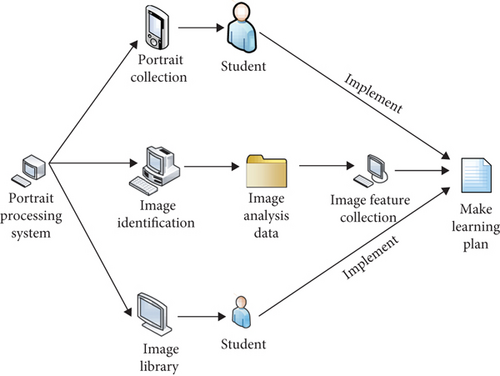
In Figure 2, first, the image database is constructed through portrait collection, and then face recognition and feature analysis are carried out in combination with the portraits collected in the online class. Finally, a comprehensive teaching plan is proposed. This method can expand the scope of students’ characteristic analysis and reduce individual omissions in students’ teaching process, which is more accurate and targeted [26]. Figure 3 shows the basic flow of student face recognition and feature analysis.
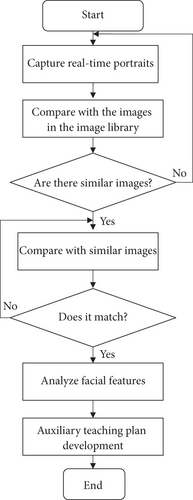
In Figure 3, first, the face recognition system is started. The identity of students is recognized after real-time face image collection and comparison with the faces in the image database. After recognition, the students’ facial features are analyzed to comprehensively analyze the students’ learning emotion and learning state [27]. The teaching plan is customized for students based on these characteristics, and finally, the teaching plan is accurately implemented to effectively improve the teaching quality.
3. Research Results
3.1. Face Recognition in Online English Learning
Confirming students’ identity based on face recognition is the first step of intelligent English teaching for students through AI. AI face recognition technology plays a crucial role in the teaching process. It can more accurately improve students’ learning interests and learning ability in the process of online English teaching. Figure 4 shows the results of image recognition for different numbers of faces.
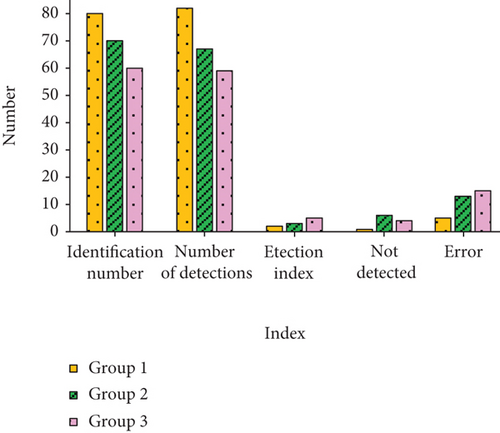
In Figure 4, face recognition and detection are carried out for three groups of students with different numbers. The accuracy of the first group is the highest, and the total number of errors is 5. The accuracy of the other two groups is relatively low, and the total number of errors is 13 and 15, respectively. It reveals that the face recognition technology for students is relatively feasible, but it still needs to be improved. Figure 5 shows the results of face recognition for students based on the illumination of the person’s face.
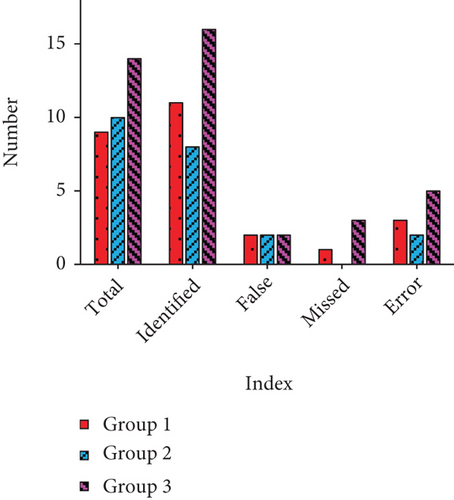
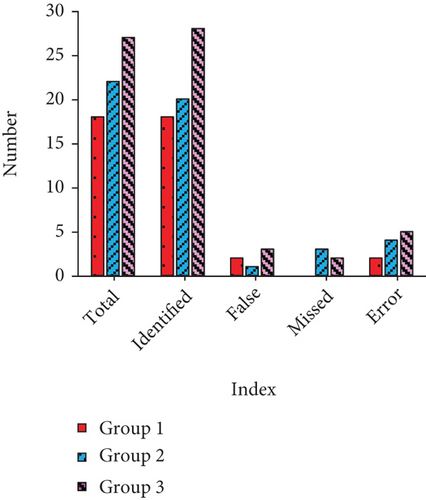
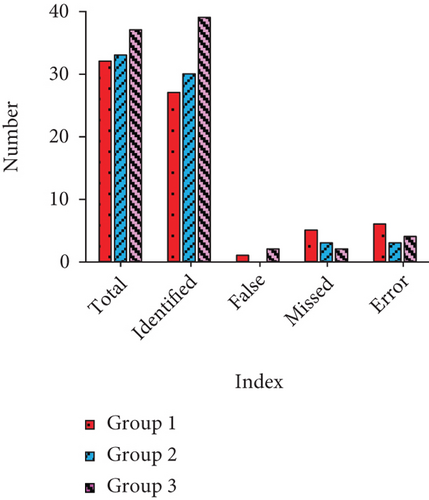
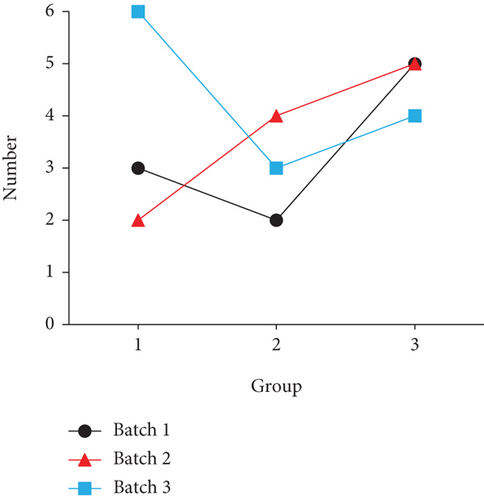
In Figure 5, when face recognition is performed with reference to the illumination of the person’s face, the accuracy is significantly improved, the number of false and missed detection is correspondingly reduced, and many zero values appear. The total number of errors is relatively reduced, and the highest total number of errors is 6. It reveals that the improvement of the AI recognition algorithm is very successful and can be applied to online English teaching to provide technical support for the development of online English teaching.
3.2. Emotional Analysis of Online English Learners
The face images in the image database established by face acquisition and the face images collected in real time are compared. Then, the angle of elevation and left and right azimuths of the image face are comprehensively classified to detect the specific dynamics of the face. Figure 6 shows the basic angle classification of face images.
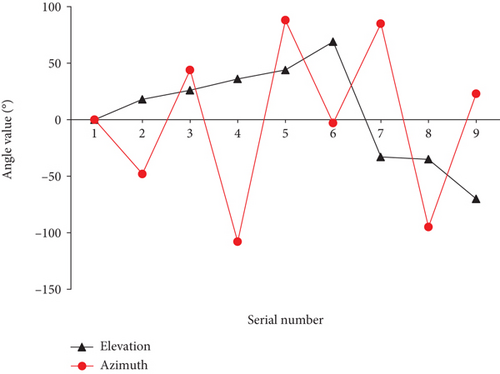
In Figure 6, first, the angle of the face image is divided into elevation and left and right azimuths. According to comprehensive analysis, the elevation is divided into 0°, 18°, 26°, 36°, 44°, 69°, 33°, 35°, and 70°, and the left and right azimuths are divided into 0°, -48°, 44°, 108°, 88°, -3°, 85°, -95°, and 23°. Each category is divided into nine subcategories. According to the angle classification, the comprehensive emotional changes of students are comprehensively identified and analyzed. Figure 7 shows the results of student face recognition from different angles.


In Figure 7, during the detection of the human face through different angles, the calculation method is relatively perfect, the detection prediction error is relatively small, and the highest number of errors is 8. Meanwhile, in the detection process, the maximum detection proportion is about 32, and the detection of the face is relatively subtle. It can also deeply explore the emotional changes of people’s faces. Figure 8 shows the emotional changes on different faces.
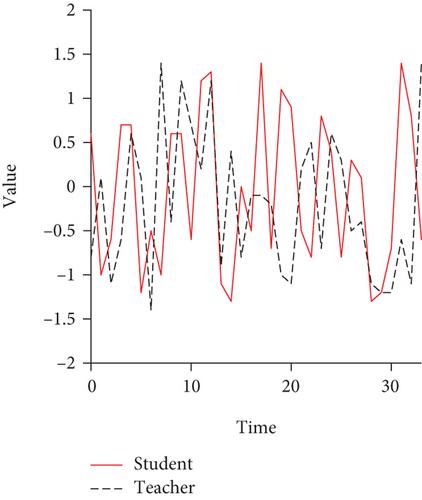
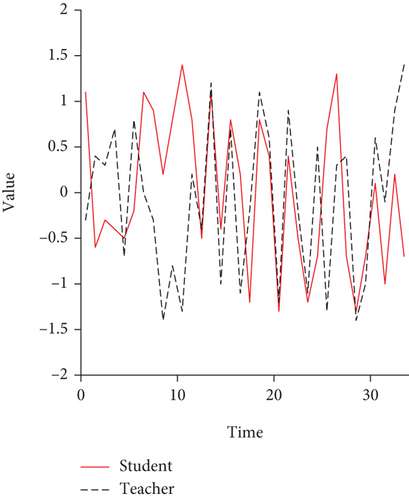
Figure 8 is an analysis of the emotions of students and teachers in the online classroom according to the analysis of different faces. Both teachers and students are the leaders of online education. Through the changes of teachers’ and students’ emotions, the teaching methods of online learning can be comprehensively adjusted to improve the efficiency of online English teaching. Figure 9 shows the comprehensive analysis of facial emotions in different groups.
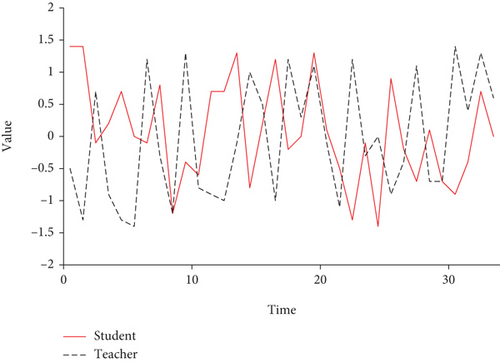
In Figure 9, the emotional changes of teachers and students can be seen after the comprehensive analysis results. The positive and negative periods of emotional changes can be accurately extracted through the analysis of teachers’ and students’ emotions. As the leader of online teaching, teachers should adjust their own state in time when their emotions are declining, so as to drive students’ self-adjustment and enable students to strengthen their awareness of autonomous learning and generate greater interest in the learning process, thus comprehensively improving the quality and efficiency of online teaching.
4. Discussion
The results show that AI image recognition technology can recognize the identity of students in online English learning, help teachers count the number of learners, and improve the attendance rate of online English teaching. Besides, it can also help students and teachers analyze the emotional changes of students in online English learning and teaching and help them adjust their emotions in time in the process of learning and teaching, so as to strengthen the quality and effect of English teaching. In the specific application, first, AI recognition technology is used to count the number of students in online English teaching, which is convenient for teachers to supervise and urge students in online learning. Then, in the teaching process, AI image recognition technology can be used to recognize the emotion of online learning students from multiple angles. The identification of students’ emotional changes can facilitate students’ timely emotional self-regulation in autonomous learning and strengthen the maintenance of learning emotion. Meanwhile, it can also facilitate teachers to detect students’ real-time emotions in the teaching process and adjust students’ learning emotions in time, so as to comprehensively improve the quality of students’ online English learning and teachers’ online English teaching. Image recognition technology can provide a better emotional reference for online English teaching teachers and autonomous learning students and reduce the decline of learning quality caused by boring teaching content in online English teaching.
5. Conclusion
English teaching has been popularized, but its teaching effect is not ideal. The promotion of online English teaching through AI image recognition technology is studied to strengthen the effect of English teaching. Under the condition of wireless network technology, AI visual sensing technology can accurately identify students’ face information and confirm students’ identity by establishing an image database. In addition, it can improve the accuracy of face recognition with the assistance of light sources, record students’ attendance in online English teaching, and strengthen teaching efficiency. The change of face emotion can be calculated comprehensively through the angle analysis of the face image and the change of each angle. Therefore, AI visual perception technology can timely extract and adjust the positive and negative emotions of teachers and students through the analysis of the facial emotions of teachers and students. It can comprehensively improve the effect of English online teaching, strengthen students’ learning quality, and strengthen students’ autonomous learning of online English. Although a lot of work has been done in algorithm research and implementation methods, this thesis still lacks comprehensive application. Future research will focus on strengthening the comprehensive application work to contribute to improving the quality of English teaching.
Conflicts of Interest
The author declares that there is no conflict of interest regarding the publication of this paper.
Open Research
Data Availability
The data used to support the findings of this study are included within the article.




